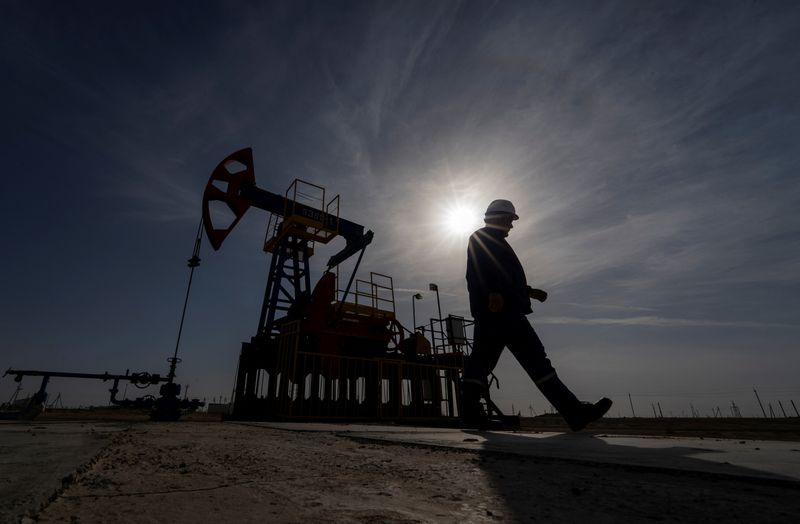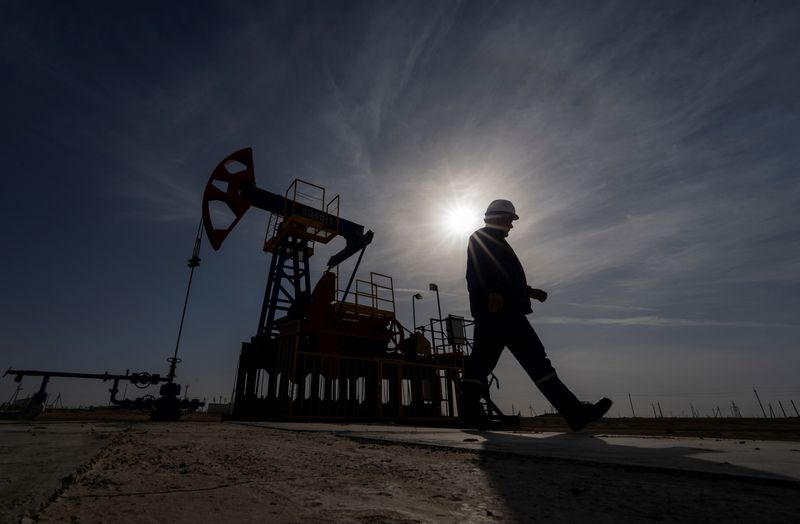Commodities
Oil prices steady as market awaits interest rate cues


© Reuters. FILE PHOTO: An oil and gas industry worker walks during operations of a drilling rig at Zhetybay field in the Mangystau region, Kazakhstan, November 13, 2023. REUTERS/Turar Kazangapov/File Photo
By Natalie Grover
LONDON (Reuters) -Oil prices were little changed Thursday as investors kept their powder dry ahead of U.S. data expected to offer further clues on the outlook for interest rates.
futures for April were down 36 cents at $83.32 a barrel by 1157 GMT. The April contract expires on Thursday and the more active May contract was down 39 cents at $81.76. U.S. West Texas Intermediate crude futures lost 26 cents to $78.28.
Brent has hovered comfortably above the $80 mark for three weeks, with the Middle East conflict having only a modest impact on crude flows.
A Reuters survery of 40 economists and analysts on Thursday forecast an average price of $81.13 a barrel for the front-month contract this year.
A variety of economic data is due on Thursday, but centre stage belongs to the Federal Reserve’s preferred inflation gauge, the U.S. personal consumption expenditures (PCE) index.
Reports on consumer and producer prices earlier in February signaled sticky inflation and a guarded approach from Fed policymakers, which prompted investors to push back expectations of rate cuts to June from March.
High interest rates have been use in many major Western economies to curb inflation, potentially reducing economic growth and oil demand.
“Faced with a flurry of data culminating in the PCE number, global stock markets have behaved in benign fashion for most of the week,” said John Evans of oil broker PVM.
If the PCE readings – as well as the core figures, which exclude volatile food and energy prices – confound expectations, he added, “there will be fireworks from this week’s thus far fettered investment tourists”.
Meanwhile, inventories have risen for a fifth consecutive week, increasing by 4.2 million barrels, the Energy Information Administration said on Wednesday. Inventories had been expected to rise by only 2.7 million barrels. [EIA/S].
An extension to voluntary oil output cuts from the OPEC+ producer group is also on the cards.
“With the demand outlook remaining uncertain, we think OPEC will extend the current supply agreement to the end of the second quarter,” ANZ analysts said in a note.
The Middle East conflict shows no signs of abating, meanwhile, with both Israel and Hamas playing down prospects for a truce in their war in Gaza. Qatari mediators have said the most contentious issues remain unresolved.
Commodities
Oil prices rise; U.S. crude inventories plunge, Russia-Ukraine truce eyed
Commodities
India’s Reliance to stop buying Venezuelan oil over US tariffs, sources say
Commodities
Oil prices climb on Venezuela supply worries

 Forex3 years ago
Forex3 years agoForex Today: the dollar is gaining strength amid gloomy sentiment at the start of the Fed’s week

 Forex3 years ago
Forex3 years agoUnbiased review of Pocket Option broker

 Forex3 years ago
Forex3 years agoDollar to pound sterling exchange rate today: Pound plummeted to its lowest since 1985

 Forex3 years ago
Forex3 years agoHow is the Australian dollar doing today?

 Cryptocurrency3 years ago
Cryptocurrency3 years agoWhat happened in the crypto market – current events today

 World3 years ago
World3 years agoWhy are modern video games an art form?

 Commodities3 years ago
Commodities3 years agoCopper continues to fall in price on expectations of lower demand in China

 Economy3 years ago
Economy3 years agoCrude oil tankers double in price due to EU anti-Russian sanctions



























